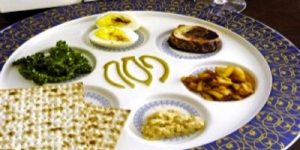What we refer to as “The Last Supper” – which is commemorated every time we take communion – was in reality a Passover Seder, a meal that Yeshua (Jesus) and his disciples would have celebrated their entire lives. However, it was at that particular Seder that Yeshua chose to give the REAL significance to this meal and holiday. The holiday of Passover (really three feasts in one — The Feast of Passover, The Feast of Unleavened Bread, and the Feast of Firstfruits) had been created and observed as a commemoration of God’s miraculous deliverance of the Jewish people from the bondage of Egypt by the blood of the lamb. However, Yeshua opened our eyes to the fact that this was simply a “foreshadowing” of our deliverance from the bondage of sin through His Blood because He indeed was the true “Lamb of God which takes away the sins of the world!”
Significance of the Passover Seder
 The Passover Seder (the beginning of the holiday of Passover) has been observed by Jews for over 3000 years. Although some of the traditions have varied through the centuries and even vary family to family, there are basic details given by Moses in Scripture that have stayed the same.
The Passover Seder (the beginning of the holiday of Passover) has been observed by Jews for over 3000 years. Although some of the traditions have varied through the centuries and even vary family to family, there are basic details given by Moses in Scripture that have stayed the same.
Millions of Jews will celebrate the Seder this year (some on the first night – the 14th of Nissan, which in 2021, that is March 27th, and some on the first two nights), some in homes with family and friends, and some at large community Seders. In addition, many non-Jewish believers in Yeshua (Jesus) the Messiah also celebrate this feast, even as the early Church did (Jewish & Gentile believers – one in the Messiah) almost 2000 years ago. Many churches even hold large community Seders attended by hundreds of people. It was the holiday of Passover, not the holidays known as “Good Friday” and “Easter,” that was used by the early Church to celebrate Yeshua’s death, burial and resurrection. Once someone’s eyes are opened, the symbolism pointing to Yeshua in the Seder meal is striking! It is even believed that some of the traditions still observed today in Jewish homes worldwide were introduced by some of the early Messianic Jewish believers!
Passover and the “Feast of Unleavened Bread” are mentioned 56 times in the Old Testament and 30 times in the New Testament. The one time (in KJV) the English word “Easter” occurs (Acts 12:4), the Greek used there is actually the word for Passover.
I personally have celebrated the Passover Seder all of my life, first as a traditional Jew, but later as a Messianic Jew who believes in Yeshua as the Jewish Messiah. As a Messianic Jew, I observe it as celebrating our deliverance from Egypt but most importantly, as celebrating God’s Perfect Lamb – YESHUA – Who delivered us from sin!
Greet your Jewish friends and neighbors at this time (in 2021 Passover is from sundown March 27th through sundown on April 4th) with “Happy Passover” (some say Happy Pesach) and pray that their eyes might be opened by the Ruach HaKodesh (The Holy Spirit) to see the true meaning of the Seder and that Yeshua is the true Jewish Messiah, God’s Passover Lamb!
Scriptures: Ex. 12:1-20,13:5-10, Matt. 26:1,2,17-30, Luke 22:1-20 (See esp. vs.15), I Cor. 5: 7-8
For additional information, visit:
http://www.geocities.com/CapeCanaveral/Lab/6562/apologetics/Seder.html http://www.messianicjewish.net/passoverconnection.html
http://godonthe.net/passover/index.html
Some of these sites have detailed instructions on how to observe a Passover Seder and even include downloads of Messianic Jewish Passover HaGadahs (translated “The Telling” and is the book used for the Seder).
___________________________________________
A Jew who believes in Yeshua (Jesus) as the Jewish Messiah.
One of the most striking traditions—the tradition of the Afikomen, is that early in the Seder, the head of the house takes a bag with three compartments each containing a piece of Matzo (unleavened bread). He then takes the middle piece and breaks it, wraps one half in a linen cloth and then hides it (or “buries it”) usually under a pillow. Depending on the household, either the children or the adults hide the wrapped matzo and it is then bought at the the end of the meal, broken and eaten by all in attendance. We believe the three matzos represent the “Father, Son and the Holy Spirit”. The middle one — the “Son — Yeshua” — is broken, buried, and later “resurrected”. It is this matzo that we use in Messianic Seders as “communion” representing His Body that was broken for us. The eating of that matzo is followed by the third cup of wine – representing His blood that was shed for us! NOTE that the traditional way matzo is baked causes it to be STRIPED, BRUISED and PIERCED!!
Read more articles by Stanley Goldenberg at: goodnewsfl.org/?s=stanley+goldenberg

Comments